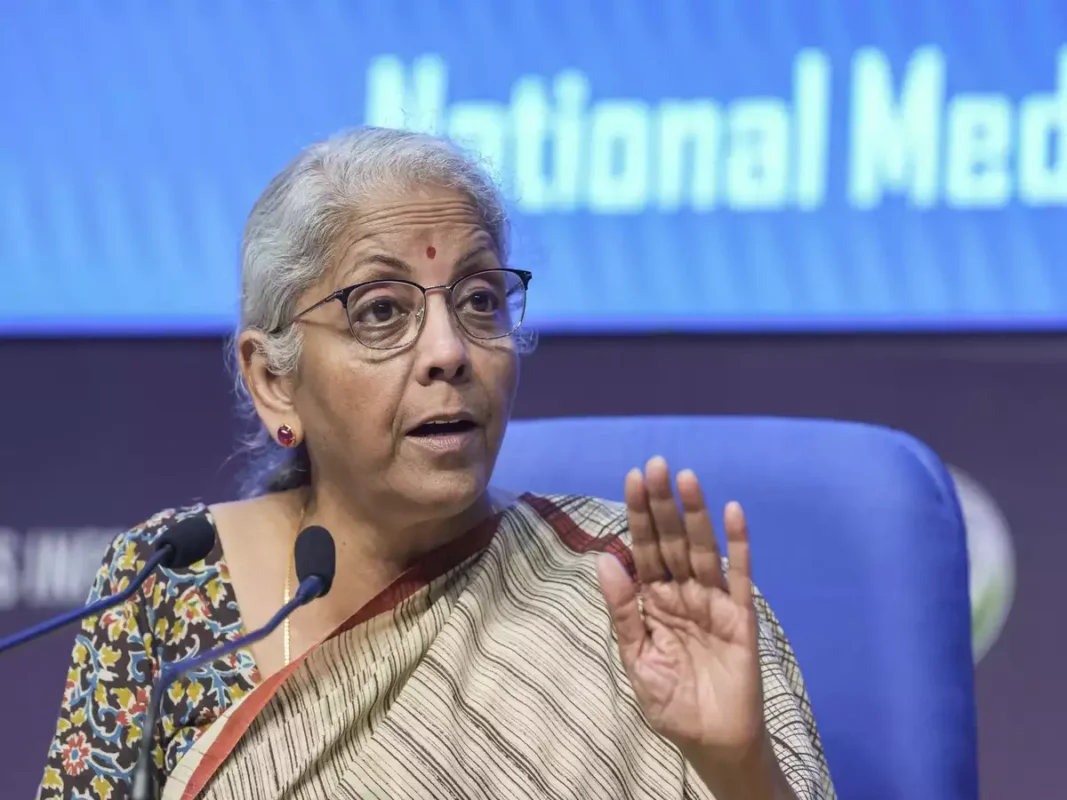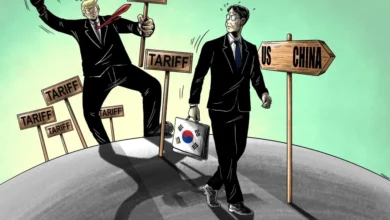September GST Collection Grew By 6.5%. Is It A Good News For The Common Man?
India’s GST collection grew by 6.5% to Rs 1.73 lakh crore in September 2024. However, after deducting the refunds of ₹20,458 crore, the Net GST collection stands at ₹1.52 lakh crore.

As India strives for the ambitious goal of becoming a $5 trillion economy, GST has emerged as the most important reform. A close look at the latest figures and trends, however, reveals a far more complex and often disturbing picture about this and the common man’s journey through this.
Issue With The Structure Of GST-
The most apparent challenge with the GST regime has been its complicated rate structure. The promise of the Indian Government was that GST is going to be a simple uniform tax regime, but it eventually became a multi-layered structure with various slabs in India.
The main GST rates for ordinary taxpayers are 0% (nil rated), 5%, 12%, 18%, and 28%.
There are some other variants as well: 3% and 0.25%.
In addition, composition scheme taxpayers have their specific rates at which they pay only 1.5%, 5%, or 6% on their turnover.
It has puzzled the business community, especially the Small and Medium Enterprises (SMEs), with confusion and compliance issues. Moreover, the classification of goods and services into different slabs has caused controversy and litigations. This phenomenon of frequent reclassification of the articles from one slab to another has introduced uncertainty to the system and made planning issues for the businesses and understanding of tax implications for the consumers.
 Adding to this complexity Cess imposed on certain items like cigarettes, tobacco, aerated water, gasoline, and motor vehicles, with rates ranging from 1% to a staggering 204%.
Adding to this complexity Cess imposed on certain items like cigarettes, tobacco, aerated water, gasoline, and motor vehicles, with rates ranging from 1% to a staggering 204%.
The additional layer of taxes does not only increase the overall tax burden but also adds to the complications in calculating and compliance processes for businesses dealing in these goods.
While the government elaborately appreciates the apparent growth in tax collection, figures itself do not necessarily translate to an improvement in economic conditions for a majority of Indians.
For example, net GST collection after refunds in September 2024 was at Rs 1.52 lakh crore, registering a 4% year-on-year growth. One can, therefore, surmise that the related trends are also gaining, albeit at considerable cost for businesses and consumers alike.
Breaking down the collections in September, revenues from domestic sources rose at 5.9 percent to about Rs 1.27 lakh crore and that from imported goods are up by 8 percent at Rs 45,390 crore. So, on the face of it, this number could look pretty high. But, beneath this, the pain that different sectors of the economy and common man are suffering through can be found.
The GST regime introduced as early as July 2017 was promised to be the one which creates unified markets, reduces cascading effects of taxes, and improves tax compliances. The execution has been anything but smooth. Finally, the string of troubles with other side effects has permitted an important thing to impact economic growth as much as to hinder it.
 The informal sector has borne the additional burden of compliance, being an integral part of India’s economy. Most small business concerns in the informal sector had to either close down or exist in a gray area with the potential for penalties and related legal complications. Millions of Indians who sought a living through the informal sector suffered from lost employment and fewer economic opportunities.
The informal sector has borne the additional burden of compliance, being an integral part of India’s economy. Most small business concerns in the informal sector had to either close down or exist in a gray area with the potential for penalties and related legal complications. Millions of Indians who sought a living through the informal sector suffered from lost employment and fewer economic opportunities.
The stresses of inflation have also been seen across different industries with the introduction of GST. The reduction in prices by removing the cascading taxes has mostly been argued for by the proponents of GST. What is evident now is actually different. Many goods and services are more expensive because usually, higher rates of taxes and costs of compliance are passed on to consumers by businesses.
Services form a significant percent of Indian GDP and have been hit the hardest. Services that were previously under lower slabs have witnessed drastic hikes under the GST regime. This is the reason why the cost to general healthcare, as well as education, among other services, which has directly affected the quality of life for common citizens, shot up.
Expectation of an integrated national market, according to advocates of GST, is yet to be achieved. Of course, abolition of state border check posts has eased part of movement of goods.
But the businesses are still stuck in the different interpretations of GST rules and their implementation in different states. This has resulted in arguments, delays, and additional costs offsetting gains that were supposed to be yielded by a unified tax system.
Among these, the most critical issue relates to the Input Tax Credit(ITC) mechanism that is the foundation of GST which was meant to curb tax cascading. It has totally been plagued with problems. Delays in ITC refunds cause cash flow problems for businesses in general and more specially as exporters are totally dependent upon getting such refunds within time to remain competitive against their global counterparts. It also had an unhealthy impact on India’s export performance that has negated its economic growth prospects.
The unintended negative consequences of the digital push that accompanied the implementation of GST can also be seen. Digitalization was expected to work towards increasing transparency in the economy and preventing tax evasion, but it has led to a digital divide instead. Small businesses and traders in rural and semi-urban areas, lacking access to reliable internet connectivity and digital literacy, have significantly been placed behind.
The frequent changes and amendment in the GST rules have placed the business world in uncertainty. Long-term planning becomes tough and investment becomes discouraging for both home and foreign investors. In fact, the uncertainty of the tax regime has acted as a deterrent to potential investors who seek a predictable and consistent regulatory environment.
Another important issue is the impact on the state exchequer of GST. The issue of compensation to states on revenue loss accounts from the implementation of GST has been a contentious issue.
Five States: Kerala, Punjab, West Bengal, Puducherry and Delhi – have reported significant revenue shortfalls, and this has strained the center-state relationships and led to lesser spending on essential areas of health, education, and infrastructure development at the state level, thereby impacting the common man.
How GST Failed Every Sector ?
 Agriculture: GST has become a matter of considerable concern for the agricultural sector as it is the backbone of the Indian economy and has been employing more people. Most agri-products have been exempted under the GST but when inputs such as fertilizers and pesticides are taxed, the cost of production increases, further putting pressure on this sector which already stays under heavy stress, thus impacting rural incomes and food security.
Agriculture: GST has become a matter of considerable concern for the agricultural sector as it is the backbone of the Indian economy and has been employing more people. Most agri-products have been exempted under the GST but when inputs such as fertilizers and pesticides are taxed, the cost of production increases, further putting pressure on this sector which already stays under heavy stress, thus impacting rural incomes and food security.
Tourism and Hospitality: Both these sectors have been significant contributors to the economy and employment of the country under the GST regime, where high taxes on hotel accommodation and restaurant services make this country less competitive for tourists, not only from within but also coming into the country. Millions have lost jobs and seen their incomes reduced in regions where tourism is an important contributor to their economy.
Automotive: a sector which once acted as the growth driver of the economy of India is also suffering under GST, with an overall slump in sales and reduced production. High tax rates on autos along with the general economic slowdown have also played a role in strangulating this sector and its chain effect has resulted in a ripple effect on job losses and reduced economic activity in manufacturing hotspots across the country.
 Healthcare: The healthcare sector also did not go scot-free from the negative fallout of GST on the health of the nation. Increased taxation on medical equipment and some health-related services in several places has pushed up the cost of medical care, which has reduced its reach for many Indians. The country is grappling with major health concerns, rising costs sinking further into the average Indian pocket.
Healthcare: The healthcare sector also did not go scot-free from the negative fallout of GST on the health of the nation. Increased taxation on medical equipment and some health-related services in several places has pushed up the cost of medical care, which has reduced its reach for many Indians. The country is grappling with major health concerns, rising costs sinking further into the average Indian pocket.
The Education Sector: It is another sector of social development, and no room has been spared for GST. Education itself is exempted, but most educational services and materials are charged with tax, which enhances the cost of education as a whole. In a country like ours, where vast sections of people cannot afford quality education, GST has thereby potentially widened the educational gap
Real-estate: While the intent was to bring in greater transparency to the sector, the complexity of the tax structure has led to increased costs in a number of cases, thereby increasing home ownership problems for the average Indian.
For the common man, claims by GST that it will bring down prices of goods and services largely remain unfulfilled. In several cases, the benefit of Input Tax Credit(ITC) has not been passed down to consumers but rather siphoned off by businesses. Consequently, the public, promised reduced prices and simplicity in the tax regime, have been cheated into increasing costs and greater complexity.
 Textiles and Handloom: have been severely affected, with severe hardship for millions of Indian women mainly as major costs arising from the tax on various inputs and compliance burden per small weavers and artisans increased. Most such artisans are being forced out of traditional crafts and, consequently, the cultural heritage and the livelihoods also.
Textiles and Handloom: have been severely affected, with severe hardship for millions of Indian women mainly as major costs arising from the tax on various inputs and compliance burden per small weavers and artisans increased. Most such artisans are being forced out of traditional crafts and, consequently, the cultural heritage and the livelihoods also.
Indeed, one of the particular harsh spots for the GST has been the large unorganized sector in India. Millions of small traders, artisans, and service providers have found themselves having to operate outside their earlier informal or exempt status under the regular tax net. Many face enforced shutdowns or operate at reduced capacities with losses in livelihoods and skills that can be passed on to the next generation.
Through GST, the middle-class population has on average, faced an increase in the general price level. From eating out to purchasing all household goods and miscellaneous items, tax incidence has been higher on most of these goods and services that are part of middle-class consumption. It has seen more reduction in discretionary spending leading to overall decline in aggregate demand and growth.
What Is The Real Story Of GST?
The promise of GST boosting India’s GDP growth also failed. As the government continues to show positive figures, real ground reality tells a different story. Global economic challenges compounded the economic slowdown post-GST, jeopardizing India’s dream of becoming a $5 trillion economy by 2024-25.
The continuous changes and modifications in the GST structure, which is well-intended to eradicate problems but have now created uncertainty, does not help businesses in investing long-term. Consumers are confused as regards tax rates on sundry products and services.
Moreover, the GST Council-the body that has been established to be a joint authority of both the central government and the states-has also been seen to carry an agenda of the central government in most ways, causing imposition of decisions that may not necessarily benefit all the states or sectors of the economy, adding further strain to the federal structure of the country.
The technology infrastructure and mechanisms that were meant to support GST – the GSTN portal – has numerous glitches and breakdowns. This technical hiccup delays returns filing, claims for refunds, and payments processing, which is making compliance woes for businesses and further eroding confidence in the system.
 So while the GST was promised to India with transformation of its economic landscape and propelling it toward a $5 trillion economy, reality has been pretty different from that. These complexities in structure have caused problems concerning multiple tax slabs, frequent changes, their compliance burdens, and inflationary impacts on businesses and consumers. The common man, far from benefiting from an easier tax regime and lower prices, was instead handed increased costs and economic uncertainty.
So while the GST was promised to India with transformation of its economic landscape and propelling it toward a $5 trillion economy, reality has been pretty different from that. These complexities in structure have caused problems concerning multiple tax slabs, frequent changes, their compliance burdens, and inflationary impacts on businesses and consumers. The common man, far from benefiting from an easier tax regime and lower prices, was instead handed increased costs and economic uncertainty.
The GST collection in September 2024 touching Rs 1.73 lakh crore might appear impressive, but it actually describes the deeper economic distress that prevails at the moment and does not accurately state the condition of the Indian economy. Moving ahead on its economic trajectory, it is obvious that India requires the GST regime, as of now, to be more of a facilitator rather than an impediment in growth. Serious reforms and simplifications would be required to start addressing the numerous issues within the system, even to the level of bringing the tax slabs and the rate structure to relative stability.




